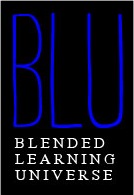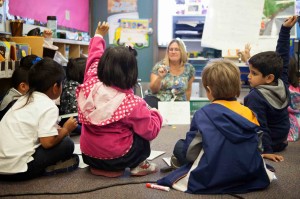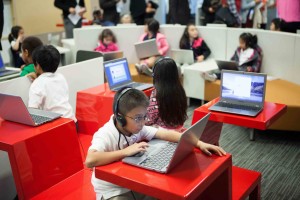 The Blended Learning Universe (BLU) is a robust catalog of blended-learning programs that grew out of our research for “The rise of K-12 blended learning: Profiles of emerging models.” What started with just 40 profiles from our white paper has grown to include more than 100 profiles and case studies detailing blended-learning initiatives from around the world. This is the second in a series of blog posts highlighting some of the promising and exciting innovations the BLU is capturing.
The Blended Learning Universe (BLU) is a robust catalog of blended-learning programs that grew out of our research for “The rise of K-12 blended learning: Profiles of emerging models.” What started with just 40 profiles from our white paper has grown to include more than 100 profiles and case studies detailing blended-learning initiatives from around the world. This is the second in a series of blog posts highlighting some of the promising and exciting innovations the BLU is capturing.
***
Some of my most vivid memories of elementary school involve a lot of organized chaos in the classroom and more than a few stern lectures from my teachers about too much friendly conversation. As a result, when Milpitas Unified School District (Milpitas), in Milpitas, Calif., invited our team to tour two elementary schools—Joseph Weller Elementary School and Curtner Elementary School—that were implementing blended learning, I naturally expected to find a noisy environment and plenty of distracted students. Instead, in every classroom and learning lab we visited, students were working quietly and independently at computers and, despite their young ages, seemed genuinely engaged in the online curriculum. The use of technology, in turn, allowed classroom teachers to dive deeper into the learning material with individuals or small groups of students and freed the learning lab teacher to provide individualized support to students who needed it.
 We visited Joseph Weller Elementary School (Weller), which is in its second year of using Lab Rotation and Station Rotation models, and Curtner Elementary School (Curtner), which is in its first year of using a Station Rotation model. Although the schools’ implementations were different, there were several benefits of blended learning that I observed at both schools:
We visited Joseph Weller Elementary School (Weller), which is in its second year of using Lab Rotation and Station Rotation models, and Curtner Elementary School (Curtner), which is in its first year of using a Station Rotation model. Although the schools’ implementations were different, there were several benefits of blended learning that I observed at both schools:
- Improved classroom management – It has become such a commonly cited benefit of blended-learning Rotation models that it almost sounds cliché, but the students’ focus on their online content really does allow teachers to provide more individualized support and instruction. And for those who argue that computers are functioning primarily as babysitters, go watch the way students are engaging with the software and coursework at Milpitas. Administrators have also found that disciplinary issues have dropped precipitously thanks to increased student engagement, and that the lack of distractions has allowed students to truly focus on learning.
- Individualization of student learning – The primary content provider for the district is i-Ready, whose adaptive platform allows students to work individually and progress through the content at their own pace. As I walked around the classrooms and learning lab, most of the students were at different points in the curriculum and teachers were able to help students with individual issues. In traditional learning models, a teacher doesn’t have the time to ensure that all of the students have understood and mastered a certain lesson, so occasionally teachers move to the next lesson before some students are ready. But for students to progress through the i-Ready curriculum, they must demonstrate their understanding of the concept and thus have the opportunity to demonstrate competency in each lesson or unit.
- Availability of real-time student data – This was obviously more difficult to actually observe, but school leaders have mentioned that i-Ready’s software could produce real-time data for each student so that teachers could monitor student progress on a day-to-day basis and pinpoint areas where certain students or entire classrooms of students were struggling.
- Flexible design – School leaders recognized the importance of creating an innovative learning space to support
 innovative learning models. Although Curtner and Weller’s students are still restricted to traditional classrooms for Station Rotation, the learning lab at Weller has some unique features. The lab routinely fits more than 100 students and features an open design, where students are free to work at desks, tables, or even bean bag chairs. Plus, all of the furniture is portable so that the room can be redesigned to fit students’ needs. This flexibility allows students to feel comfortable as they learn and enables teachers and students to easily reconfigure a classroom if the exercise calls for collaborative work.
innovative learning models. Although Curtner and Weller’s students are still restricted to traditional classrooms for Station Rotation, the learning lab at Weller has some unique features. The lab routinely fits more than 100 students and features an open design, where students are free to work at desks, tables, or even bean bag chairs. Plus, all of the furniture is portable so that the room can be redesigned to fit students’ needs. This flexibility allows students to feel comfortable as they learn and enables teachers and students to easily reconfigure a classroom if the exercise calls for collaborative work.
Like any model in its relative infancy, however, there are a number of drawbacks or obstacles that the district is actively working to overcome:
- Content limitations – Although i-Ready is an exciting product, school leaders have indicated that older students sometimes lose interest in the content after a few months. As a result, it is important for schools and districts to consider partnering with multiple content providers to give students variety.
- Data overload – Access to large swaths of data is great, but Milpitas and nearly every other district using blended learning are still struggling to use the online data to inform offline instruction. Determining what data sets are useful and informative is no small task, and district leaders are still working on ways to use the data effectively. The other issue is data from content providers has its own limitations. For example, Milpitas is focused on closing the achievement gap, but the data from i-Ready can’t be broken into sub-groups based on demographics, so Milpitas is unable to see what progress, if any, has been made.
- Instruction synchronization – Personalized learning for every student is what Milpitas hopes to eventually achieve, but in a model where 30 students can be at 30 different spots in the material, teachers have found it difficult to find ways to make sure their offline instruction is useful to everyone.
What started as a pilot program at two Milpitas elementary schools last year has grown quickly. At the start of the 2013-14 school year, the district had nine elementary schools that were implementing Rotation models to varying degrees and a few middle and high schools that were beginning to experiment with blended learning. Although the district has not yet publicly released the data from its benchmark results from this fall, district leaders have indicated that the results show promising student growth across all Milpitas schools. For more information about Milpitas schools (including Robert Randall Elementary School)—or about more than 100 other blended-learning programs worldwide—check out the BLU.
